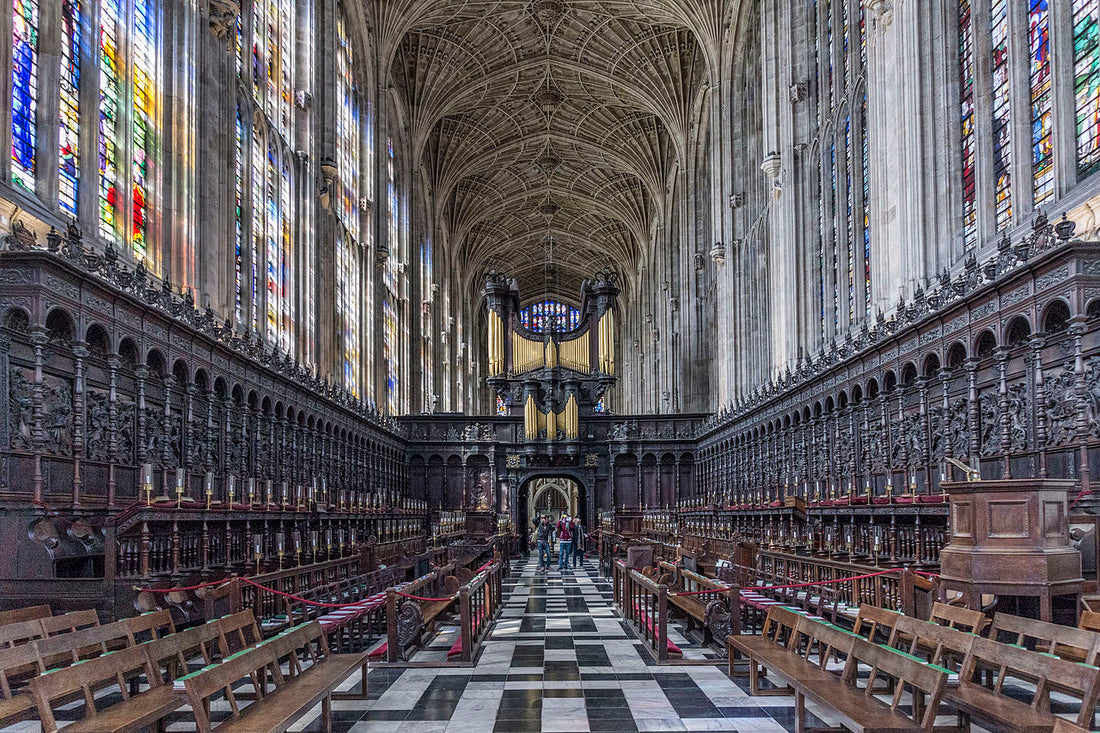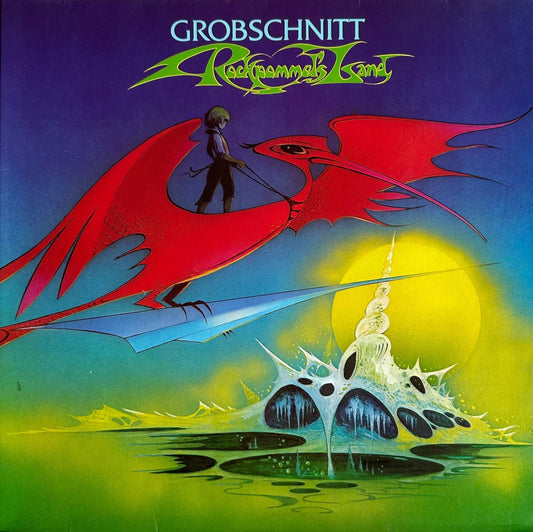Late this May I fulfilled a longstanding wish—to attend Choral Evensong at King’s College Chapel, Cambridge. Director Stephen Cleobury retired at the end of June; this was one of the last times he presided over the Choir and the service. It was quite an evening. The Chapel itself, with its high vaulted ceiling, stained glass windows, and splendid Late Gothic architecture, provides an inspiring visual environment. If you also know something about its history and the Choir’s continuing significance, you’ll be properly awed before you ever take a seat.
Those who queue up early get to perch in the choir stalls. That way they hear more of the Choir and less of the room, which I’m told has a 12-second reverberation time. (From the stalls, it feels more like three or three-and-a-half; see comparisons here). As the choirmaster makes his way to the lectern, an inevitable hush falls.
Yet when the Choir begins to sing, one feels as if the chapel has been flooded with light. The intensity of the sound is physically shocking. If I hadn’t been seated already, I might have collapsed on the spot. (The Introit for 31 May was Byrd’s brief, exultant Psallite Domine, perfect for the moment.) Somehow the Choir has, over the centuries, learned to use the Chapel’s vast inner space as a kind of amplifier. They are not defeated by this room; instead they seem to regard it as their own Marshall Stack. As that day’s service continued with Byrd, Victoria, and Tye, I adjusted to the extraordinary music being made, but I was never less than astonished by its beauty and coherence.
Great works from the British cathedral tradition—Palestrina, Victoria, Byrd, and Tallis; Parry, Vaughan Williams, Britten, and beyond—form the core of this Choir’s repertoire. The Chapel thoughtfully provides well-worn books with English texts for the most frequently used service music. Nevertheless, selections are continually refreshed and varied, venturing well beyond the core; recordings issued on the King’s College label reflect this effort as well. Their newest SACD, issued in June, features music by Herbert Howells (1892–1983), including some first recordings.
Howells and the King’s College Choir enjoyed a long, fruitful association. Indeed, one of his earliest efforts, the Three Choral Anthems (1918–20), has remained in their repertoire for years. The second of these anthems, “A Spotless Rose,” will be familiar from its frequent appearances in the Choir’s annual Christmas Eve Service of Lessons and Carols.
Here the basics of Howells’ style are already apparent: long, sinewy melodic lines and richly impressionistic harmonies. Together they impart an inward, yet sensuous quality to whatever text is set. By 1944, when Howells created the Collegium Regale canticles for King’s, he was capable of creating a Magnificat that reflected his deepest concerns, including what biographer Paul Spicer awkwardly terms an “almost obsessive feeling for women.” (Translation: the composer was known for his roving eye.) Regarding the Song of Mary, Howells suggested that “the mighty should not be put down from their seat with a brute force which would deny the canticle’s feminine association.” Accordingly, he prefaced the parts in the Magnificat text about God the Father’s “strength with His arm,” etc. etc., with an exquisitely delicate opening:
Disc 1 is given over to the Collegium Regale Te Deum and Magnificat plus An English Mass, from 1955–56. Howells’ relationship with religious faith was complicated, to say the least. After the unexpected death of his son Michael—from polio, at the age of nine—his music more often voiced dark feelings about the nature of the universe. Consider the Kyrie of the Mass:
Disc 2 offers a contrasting turn: Howells’ Cello Concerto, with two of its three movements newly reconstructed from the composer’s short scores and sketches. Cellist Guy Johnston, a former King’s Chorister, is the soloist; Christopher Seaman, another King’s alumnus, conducts the Britten Sinfonia. Here’s a bit of the finale:
Cleobury rounds things out with three of Howells’ organ works. These show the influences of Tallis, Vaughan Williams, and others. Nevertheless, if you want to hear the Chapel organ in all its glory, get Cleobury’s 2017 recital, The King of Instruments: A Voice Reborn. It’s a thrilling demonstration, especially in multichannel sound.
Other Voices, Other Rooms: Years ago, just as SACD and DVD-Audio were being introduced, I served as general editor of recording reviews for Choral Journal. Many of the choral discs we received for review were offered in the new formats, especially SACD. I devoted most of one column to its advantages, technical and aesthetic; several of my reviewing colleagues also took up the cause. Choral labels (like King’s and Gloria Dei Cantores) and hi-res independents (like 2L and Sono Luminus) have continued to champion immersive vocal sound. Before its untimely demise, Harmonia Mundi USA also issued superb multichannel choral recordings.
Why did choral fans apparently take to multichannel in a (relatively) big way? For many of us, singing in the midst of other singers—being surrounded by vocal sound—was transformative. It never got old. Anyone who’s ever sung in a group (especially in scrambled or quartet formation) will recognize that special, shared energy. You hear everything. You’re part of it.
Two new recordings from Morten Lindberg’s 2L bring us fresh hi-res choral sound, and—like the King’s College releases—they reinforce the foundational importance of the room. Lindberg likes to work in big churches with high ceilings. Both of his new albums were recorded in Oslo’s Uranienborg Church, which offers that sort of space. Yet the music on Trachea (2L 154) could hardly be more different from that on Himmelborgen (2L 149).
Himmelborgen is a hymn collection with surprises. Some familiar congregational songs are given clean, straightforward treatments:
Other tunes receive elaborate arrangements that amount to re-composition. I’ll spare you the utterly avant-garde “Amazing Grace,” but do check out track 12: “Å, for djup i Jesu kjaerleik” (“O the deep, deep love of Jesus”), a 19th-century English hymn, which gets a new eight-part arrangement by Henrik Ødegaard (b. 1955) that “exploits the tune’s folk music qualities.” (Okay, see if you can hear the folky bits.)
There’s something for everyone in Himmelborgen. Yet it’s all sung in Norwegian and features hymns with special meaning for Norwegians. You may find Trachea and its emphasis on new music more rewarding. The Schola Cantorum of the University of Oslo is joined variously by four horns, a jazz saxophonist, and a Hardanger fiddler. Here’s an excerpt from Snilla Patea:
And the impressive title track:
By the time you read this, 2L’s physical package, consisting of a hybrid SACD and a Blu-ray Pure Audio disc (with height channels and more) will be available in addition to the downloads mentioned in Jason Victor Serinus’s review. Excellent SQ, of course.
More Howells: What if you’ve heard the Howells album from King’s and want to hear more of him? If you preferred the choral works to the complex, ruminative Cello Concerto, perhaps your next Howells should not be more choral music but instead—and I know this is counterintuitive—the short, accessible instrumental pieces on a recent Naxos album: String Quartet No. 3, “In Gloucestershire,” Lady Audrey’s Suite, and the A-minor Piano Quartet. It’s got lovely melodies but doesn’t ask you to wade through miles of contrapuntal underbrush. Here’s a taste of “In Gloucestershire.” (There’s more of everything on YouTube.)
If you’re not so taken with Howells’ service music but are quite fond of “major works,” try the dramatic Stabat Mater (Naxos again) recently recorded by David Hill, The Bach Choir, and the Bournemouth SO. Hill incorporates crucial tempo changes Howells made in 1965, casting this little-known work in a new light. The result is electrifying.
There’s no way that brief excerpts can give you a sense of the profound emotion in Howells’ Stabat Mater. I’ll just say the composer overcomes a lugubrious medieval text with bold strokes that hold your attention while never sacrificing the overwhelming grief at the center of the work. Soloists Benjamin Hulett and Alison Hill shine here, and also on the 1922 Sine Nomine that rounds out the album:



